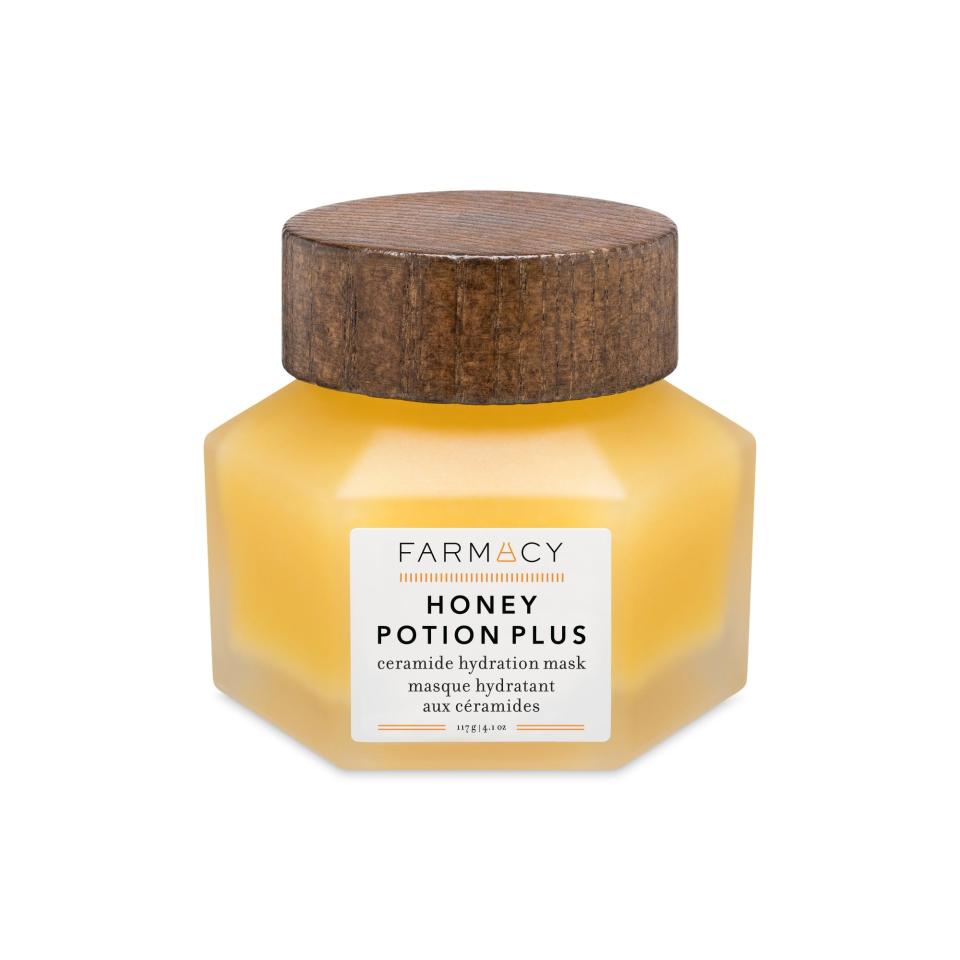Why Every Dermatologist Loves Glycerin

"Hearst Magazines and Yahoo may earn commission or revenue on some items through these links."
When skin needs a boost of moisture, you’re likely to reach for a hydrating ingredient like hyaluronic acid, ceramides, or even squalane. But glycerin, the time-tested ingredient that serves as the backbone of thousands of hydrating products, is arguably more effective. But what exactly is glycerin? And why the sudden reboot that’s bringing attention to it? Ahead, we ask dermatologists for a complete lesson on glycerin’s particulars, how to work it into your current skin care routine, and why it’s taken a backseat to other hydrating ingredients yet deserves center stage.
What Is Glycerin?
Glycerin is a hydrating ingredient in water-based skincare products, including moisturizers, serums, lotions, creams, cleansers, and even some makeup. The clear, thick liquid is made synthetically or sourced from plants or the fat that transpires during soapmaking. Dan Belkin, a board-certified dermatologist in New York, says glycerin is a humectant, which allows the skin to hold onto water, and one of the most effective ones. Often called a “hydration hero,” glycerin, which also lends a buttery-like consistency to products, is one ingredient to incorporate into your skin care routine. “It is particularly effective at drawing water into the skin from below or from the air, which causes the skin to appear smoother,” Belkin shares.
For most humectants to work, there must be high humidity levels in the air for the ingredient to pull in water. But Belkin says glycerin can uniquely achieve its humectant capabilities even when humidity levels are low. “Like any good moisturizer, glycerin also helps support the skin’s barrier function,” he adds. Plus, it helps increase the activity of aquaporins, proteins that control the flow of hydrating elements in the skin’s upper layers.
The better hydrated the skin, the more water it can retain, and the more equipped it is at protecting itself against irritation. “Glycerin prevents water loss in the skin, which allows for the skin’s natural oils to nourish and repair,” Elizabeth Houshmand, a board-certified dermatologist in Dallas, explains. “The ingredient can reach down to the dermis layer of the skin and bring moisture up so that the skin can plump and hydrate itself from within.”
The Skin Benefits of Glycerin
The main benefit of glycerin is, obviously, well-hydrated skin that appears smooth, plump, and dewy. But that’s not all it does. Shereene Idriss, a board-certified dermatologist in New York and the founder of the PillowtalkDerm skincare line, says glycerin helps shield the skin from dehydration induced by environmental aggressors. “With glycerin-based products, the skin stays hydrated longer even after use. For example, a glycerin-based chemical exfoliant is top-tier, in my opinion, because you get the benefit of exfoliation while the skin remains hydrated,” she says.
Glycerin is also skin friendly and noncomedogenic, making it safe for all skin types. Houshmand calls it a great option for keeping acne-, rosacea-, and eczema-prone skin hydrated since it’s nonirritating. However, those prone to acne should use glycerin sparingly and cautiously, since a heavy hand can leave the skin feeling greasy.
Most products contain glycerin at 5 to 10 percent. Concentrations under 50 percent allow glycerin to exhibit emollient properties, which help soften the skin. Higher concentrations are more difficult to formulate with, resulting in a sticky texture. “Studies show that skincare products containing glycerin can significantly improve the appearance of rough, dry skin,” Houshmand adds. One of her favorite glycerin-rich creams is Charlotte Tilbury’s Magic Cream, and for toner, Versed’s Baby Cheeks Hydrating Milk, which doubles as a hard water residue remover.
In cleansers, glycerin prevents the stripping of the skin’s natural oils, which averts a tight, dry feeling. And glycerin can help enhance the absorption of other topical ingredients, especially lipids. Houshmand says to look for glycerin-based products compatible with your skin type: “Stick with quality ingredients and products that have glycerin higher in the ingredient list.” Kiehl’s Ultra Facial Cleanser is her pick for an everyday cleanser with glycerin, while Belkin is a fan of U Beauty’s The Mantle Skin Conditioning Wash, “because it’s very hydrating. The glycerin certainly contributes to this as a humectant.”
The antimicrobial and antiviral ingredient can even be used on post-laser skin to attract water to the skin and keep it there as it heals. “Alongside panthenol, which helps speed up regeneration and repair while moisturizing the skin, research shows that glycerin-based hydrogels help control infections in wounds, which lasers create in the skin,” Houshmand explains. She recommends her patients use Neocutis Aftercare Soothing Cream post-laser to hydrate the skin. For drugstore options, the CeraVe Healing Ointment and tried-and-true Aquaphor Healing Ointment are her go-tos.
Why Glycerin Is Popular Right Now
For years, glycerin has slid under the skincare radar as a trendy ingredient. But that’s changing as more brands are bringing glycerin to the forefront. Skincare brand Experiment shines the light on glycerin as a hero ingredient in its two-SKU line. Experiment’s Super Saturated Serum (which doubles as a treatment mask) contains a whopping 30 percent of glycerin, allowing the serum to be delivered deep within the skin to hydrate while it repairs the skin barrier.
“Glycerin has always been a superstar hydrating ingredient. I, for one, have been singing its praises long before the beauty industry began touting hyaluronic acid as the latest and greatest ingredient on the market,” Idriss says. “People get caught up with trends and newness, yet glycerin has been used in cosmetic formulations for more than 50 years, and now the pendulum has swung again. Sooner or later, everything old is new again.” She adds that glycerin has antimicrobial properties, making it a natural preservative—a plus for those who prefer cleaner ingredients.
Belkin credits the recent attention on glycerin to its track record of being a safe, reliable ingredient even at higher concentrations: “All of that is propelling the skin hydrator into the limelight. Besides being cheap, accessible, and effective, skincare companies and consumers are starting to recognize that there’s no reason to look elsewhere for a great humectant in skincare.” Plus, with virtually no potential for irritation or sensitivity—a concern among many consumers—glycerin reigns supreme as a dermatologist’s favorite.
Is Glycerin Better Than Hyaluronic Acid?
Some dermatologists are all for hyaluronic acid, while others are team glycerin. Houshmand says clinical data even deemed glycerin “the most effective humectant available” to increase hydration on the top layer of skin in comparison to other hydrating ingredients such as lactic, glycolic, and hyaluronic acids; propylene and butylene glycols; sorbitol; and urea. That’s because glycerin’s low molecular weight (92 daltons, to be exact) can penetrate deeper into the skin.
Although both humectants provide hydration, Houshmand says hyaluronic acid and glycerin differ significantly, explaining that “glycerin adds moisture and balance, whereas hyaluronic acid is more likely to stop dry skin from getting worse.” Hyaluronic acid is more expensive than glycerin and, as Belkin points out, requires combining it with occlusive-type moisturizers to keep the hydration locked in. “Hyaluronic acid is thinner and more liquidy than glycerin, and it also has less occlusive and emollient properties,” the derm adds. Also, misusing hyaluronic acid can cause skin dehydration and even irritations when there’s a lack of moisture on the skin’s surface.
Ultimately, the choice is yours, but Idriss believes hyaluronic acid is often used instead of glycerin simply because of its trend appeal: “So many brands publicize hyaluronic acid as their hydrating ingredient.”
How to Use Glycerin
Although glycerin is a standard base in most moisturizing creams and lotions (it’s the hydrating base ingredient in Idriss’s PillowtalkDerm Major Fade Solution System because of the multitude of benefits), especially oil-free formulations, it’s bound to be in any water-based product. But the one type of product you’ll be hard-pressed to find glycerin in is anhydrous (waterless) and oil-based formulations, which contain silicone rather than glycerin.

Honey Potion Plus
farmacybeauty.com
Just because a product contains glycerin doesn’t mean it won’t sit alongside other popular moisturizing ingredients like ceramides and panthenol. Idriss explains that ceramides form a protective layer to limit moisture loss and protect against visible damage from pollution and other environmental stressors. Panthenol has anti-inflammatory and skin-protecting abilities. Together, the combos make for well-hydrated and better protected skin.
Glycerin benefits all skin types, but Idriss says skin type is a determining factor in the delivery vehicle to incorporate into your routine. “For example, if you have very dry skin, look for a rich glycerin-based cream paired with ceramides to deliver hydration. I recommend the glycerin-based Aveeno Calm & Restore line for really dry skin, damaged skin barriers, or those with eczema,” she says. “If you’re oily, opt for a glycerin-based gel moisturizer.” Other glycerin-rich skincare products that sit at the top of the lists of the doctors we speak with include Farmacy Honey Potion Renewing Antioxidant Hydration Mask, SkinBetter Alto Defense Serum, Clinical Skin Vitamin C Pro-Collagen Serum, and Alastin Restorative Skin Complex.
To fully reap the benefits of glycerin, apply the product to damp skin morning and night; this will help further draw moisture into the skin. But be mindful of how much you use. Anything more than the recommended amount can leave the skin with a tacky or greasy feeling. And that’s about the only downside to this magical moisturizer.
You Might Also Like

